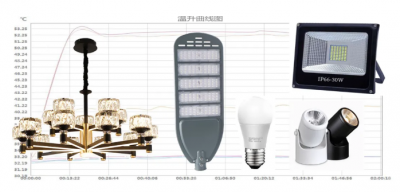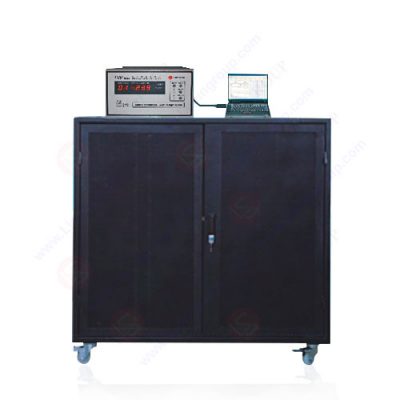In LED lighting products, due to the heat generated by some high-current components, their own temperature rise is often too high. Working in this state for a long time may reduce or destroy the characteristics of the insulating materials in the product, resulting in electric shock or even fire. The dangerous result of the product; the temperature of the accessible parts such as the product shell and operation control parts is too high, and there is a danger of burns. Meanwhile, the LED is more sensitive to temperature, and the high temperature will seriously affect the service life of the LED. Therefore, in order to ensure the safety performance of LED lamps, the temperature rise test is one of the important items in the safety test of LED lamps.

Temperature rise graph
LED lamp temperature rise test standard:
1. IEC/EN 60598-1, GB 7000.1 <Luminaires Part 1: General Requirements and Tests>;
2. IEC/EN 60598-2-1, GB 7000.201 <Luminaires Part 2-1: Special Requirements Fixed General Luminaires>;
3. IEC/EN 60598-2-2, GB 7000.202 <Luminaires Part 2-2: Special Requirements Recessed Luminaires>;
4. IEC/EN 60598-2-3, GB 7000.203 <Luminaires Part 2-3: Special Requirements for Road and Street Lighting Luminaires>;
5. IEC/EN 60598-2-4, GB 7000.204 <Luminaires Part 2-4: Special Requirements Portable General Luminaires>;
6. IEC/EN 60598-2-5, GB 7000.7 <Luminaires Part 2-5: Special Requirements Floodlights>;
7. IEC/EN 62560, GB 24906 <Safety requirements for self-ballasted LED lamps above 50V for general lighting>;
8. IEC/EN 62031, GB 24819 <Safety Requirements for LED Modules for General Lighting>;
9. IEC/EN 61347-1, GB 19510.1 <Light Control Device Part 1: General Principles and Safety Requirements>;
10. GB 19510.12, IEC/EN 61347-2-11 <Lamp control device Part 2-11: Special requirements for miscellaneous electronic circuits used in conjunction with lamps>;
11. IEC/EN 61347-2-13, GB 19510.14 <Light Control Device Part 2-13: DC or AC Electronic Control Device for LED Module>.
Normal temperature rise test requirements:
1. The tested room temperature should be controlled between 25+5°C.
2. The lamp under test should be connected to a voltage 1.06 times the rated load.
3. During the normal working temperature rise test, measure the temperature at the most heated position of the lamp under normal use conditions. During the test, the accessible parts, insulating materials, internal wiring or installation environment of the lamp must not affect the formation of a safe temperature.
4. Measure the temperature rise of the luminaire under the simulated failure during the abnormal working temperature rise test. In this case, the temperature of the parts, internal wiring and mounting surface of the lamp should not exceed the standard specified value.
5. If the components of the luminaire can be rotated or moved, it should be fixed in the place where the highest temperature is generated during the test;
6. Different test points need to be done according to the specific lamps: lamps and lanterns, the surface temperature of the bulb should not exceed 300°C; the temperature of the terminal block should not exceed 110°C; the temperature of the contact point between the recessed lamp body and the ceiling should not exceed 90 °C; the temperature of the wires in the junction box must not exceed 75 °C.
Laboratory equipment introduction:
The TMP-8/TMP-16 multi-channel temperature tester developed by LISUN can measure eight or 16 sets of temperature data at the same time, and the measurement data can be accurate to 0.1°C.
Windshield: It can provide a relatively constant no-wind environment and provide a guarantee for accurate temperature measurement.

Temperature Rise Test System
Windshield production requirements:
• The windshield of the luminaire is designed and manufactured in accordance with the requirements of GB7000. 1/IEC60598. 1 Appendix D, and is suitable for the temperature rise test under normal and abnormal operation of the luminaire.
• The bottom surface of the windshield is 20mm plywood, the rest is double-layer metal mesh panels, the spacing between the inner and outer mesh panels is 150mm, and the ventilation rate is about 40%; the windshield is equipped with mounting plates suitable for installation of various lamps: all mounting panels , the screen is sprayed with black matt paint.
1. Main technical parameters:
• Outer layer size:2000*2000*2000mm (length×width×height)
• Inner layer size:1700*1700*1850mm (length×width×height)
• Screen aperture: about φ2mm
• The area of the ventilation holes accounts for about the total area of each shell: ≈40% (ventilation rate)
• Floor size: 2000*2000*20mm (length × width × height)
• Surface spray: black matt paint.
2. Installation requirements:
• There is a clearance of at least 300mm around the top and sides of the windshield.
• The location of the windshield should be as far away as possible from the airflow and to prevent sudden changes in air temperature and radiant heat from the light source.
• Ambient temperature: about 25 °C. Internal sample installation requirements: the gap between the inner surface of the windshield and any part of the lamp should be at least 200mm.
3. Instructions for operation:
• The power supply used by the lamp penetrates through the hole in the wooden floor.
• The thermocouple wire penetrates through the hole in the wooden floor
• Connect the thermocouple wire to the point you need to test
• Lead the thermocouple wire out of the windshield and connect it to the temperature inspection instrument.
• Install the lamp on the sample mounting plate, connect the sample to the power supply, leave the windshield and close the windshield door.
• Use computer software to control the temperature inspection instrument, or select the test key in the temperature inspection instrument to test the temperature of the lamp and start collecting.
• After the test is completed, turn off the power, take out the lamp and use the computer software or U disk to export the test report, and print out the PDF file.

Test Report
4. Note:
• The location of the windshield should be as far away as possible from the airflow and to prevent sudden changes in air temperature and radiant heat from the light source.
• The gap between the inner surface of the windshield and any part of the lamp should be at least 200mm.
• Ambient temperature: about 25 °C.
• Prevent people or objects from hitting the windshield.
Lisun Instruments Limited was found by LISUN GROUP in 2003. LISUN quality system has been strictly certified by ISO9001:2015. As a CIE Membership, LISUN products are designed based on CIE, IEC and other international or national standards. All products passed CE certificate and authenticated by the third party lab.
Our main products are Goniophotometer, Integrating Sphere, Spectroradiometer, Surge Generator, ESD Simulator, EMI Receiver, EMC Test Equipment, Electrical Safety Tester, Environmental Chamber, Temperature Chamber, Climate Chamber, Thermal Chamber, Salt Spray Test, Dust Test Chamber, Waterproof Test, RoHS Test (EDXRF), Glow Wire Test and Needle Flame Test.
Please feel free to contact us if you need any support.
Tech Dep: Service@Lisungroup.com, Cell/WhatsApp:+8615317907381
Sales Dep: Sales@Lisungroup.com, Cell/WhatsApp:+8618917996096
Your email address will not be published. Required fields are marked *